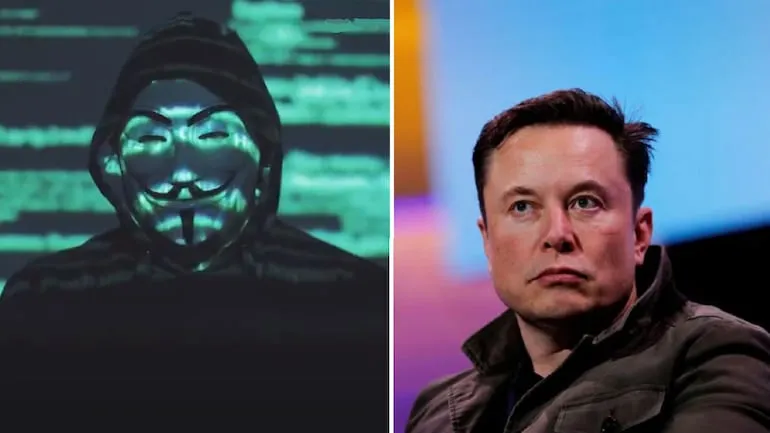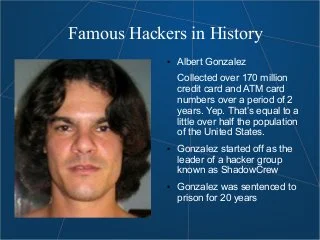indian hackers
Top 10 Indian Hackers
-
Rahul Tyagi. ...
-
Sunny Vaghela. ...
-
Sai Satish. ...
-
Koushik Dutta. ...
-
Vivek Ramachandran. ...
-
Trishneet Arora. ...
-
Rishiraj Sharma. ...
-
Anand Prakash. India's bug bounty champ is one of the best white-hat hackers in the world.
What is hacking?
Computer hacking is the act of identifying and exploiting system and network vulnerabilities in order to obtain unauthorized access to those systems. Not all hacking is malicious. White hat hackers may work in cyber security or as software engineers and testers seeking out vulnerabilities in order to fix them. Black hat hackers operate with malicious intent. That said, there is a large grey area populated by political activists and hackers who wear both hats.
Hacking costs companies and consumers trillions of dollars every year. According to CPO Magazine, by 2021, hacking attacks will cost a total $6 trillion, up from $2 trillion in losses reported in 2019. Much of the cyber crime problem stems from the same features of the internet from which we all benefit. Even the most amateur hacker can easily find all the tools they need online at virtually no cost.
The hacker onslaught didn't occur overnight. It took decades of work by now-famous hackers to discover critical vulnerabilities and reveal the strategies that established the foundations of the internet and its free-for-all libertarianism. Here's a look at the top ten most notorious hackers of all time.

Kevin Mitnick
A seminal figure in American hacking, Kevin Mitnick got his career start as a teen. In 1981, he was charged with stealing computer manuals from Pacific Bell. In 1982, he hacked the North American Defense Command (NORAD), an achievement that inspired the 1983 film War Games. In 1989, he hacked Digital Equipment Corporation's (DEC) network and made copies of their software. Because DEC was a leading computer manufacturer at the time, this act put Mitnick on the map. He was later arrested, convicted and sent to prison. During his conditional release, he hacked Pacific Bell's voicemail systems.
Throughout his hacking career, Mitnick never exploited the access and data he obtained. It's widely believed that he once obtained full control of Pacific Bell's network simply to prove it could be done. A warrant was issued for his arrest for the Pacific Bell incident, but Mitnick fled and lived in hiding for more than two years. When caught, he served time in prison for multiple counts of wire fraud and computer fraud.
Although Mitnick ultimately went white hat, he may be part of the both-hats grey area. According to Wired, in 2014, he launched "Mitnick's Absolute Zero Day Exploit Exchange," which sells unpatched, critical software exploits to the highest bidder.

Anonymous
Anonymous got its start in 2003 on 4chan message boards in an unnamed forum. The group exhibits little organization and is loosely focused on the concept of social justice. For example, in 2008 the group took issue with the Church of Scientology and begin disabling their websites, thus negatively impacting their search rankings in Google and overwhelming its fax machines with all-black images. In March 2008, a group of "Anons" marched passed Scientology centers around the world wearing the now-famous Guy Fawkes mask. As noted by The New Yorker, while the FBI and other law enforcement agencies have tracked down some of the group's more prolific members, the lack of any real hierarchy makes it almost impossible to identify or eliminate Anonymous as a whole.

Adrian Lamo
In 2001, 20-year-old Adrian Lamo used an unprotected content management tool at Yahoo to modify a Reuters article and add a fake quote attributed to former Attorney General John Ashcroft. Lamo often hacked systems and then notified both the press and his victims. In some cases, he'd help clean up the mess to improve their security. As Wired points out, however, Lamo took things too far in 2002, when he hacked The New York Times' intranet, added himself to the list of expert sources and began conducting research on high-profile public figures. Lamo earned the moniker "The Homeless Hacker" because he preferred to wander the streets with little more than a backpack and often had no fixed address.

Albert Gonzalez
According to the New York Daily News, Gonzalez, dubbed "soupnazi," got his start as the "troubled pack leader of computer nerds" at his Miami high school. He eventually became active on criminal commerce site Shadowcrew.com and was considered one of its best hackers and moderators. At 22, Gonzalez was arrested in New York for debit card fraud related to stealing data from millions of card accounts. To avoid jail time, he became an informant for the Secret Service, ultimately helping indict dozens of Shadowcrew members.
During his time as a paid informant, Gonzalez continued his in criminal activities. Along with a group of accomplices, Gonzalez stole more than 180 million payment card accounts from companies including OfficeMax, Dave and Buster's and Boston Market. The New York Times Magazine notes that Gonzalez's 2005 attack on US retailer TJX was the first serial data breach of credit information. Using a basic SQL injection, this famous hacker and his team created back doors in several corporate networks, stealing an estimated $256 million from TJX alone. During his sentencing in 2015, the federal prosecutor called Gonzalez's human victimization "unparalleled."

Matthew Bevan and Richard Pryce
Matthew Bevan and Richard Pryce are a team of British hackers who hacked into multiple military networks in 1996, including Griffiss Air Force Base, the Defense Information System Agency and the Korean Atomic Research Institute (KARI). Bevan (Kuji) and Pryce (Datastream Cowboy) have been accused of nearly starting a third world war after they dumped KARI research onto American military systems. Bevan claims he was looking to prove a UFO conspiracy theory, and according to the BBC, his case bears resemblance to that of Gary McKinnon. Malicious intent or not, Bevan and Pryce demonstrated that even military networks are vulnerable.

Jeanson James Ancheta
Jeanson James Ancheta had no interest in hacking systems for credit card data or crashing networks to deliver social justice. Instead, Ancheta was curious about the use of bots—software-based robots that can infect and ultimately control computer systems. Using a series of large-scale "botnets," he was able to compromise more than 400,000 computers in 2005. According to Ars Technica, he then rented these machines out to advertising companies and was also paid to directly install bots or adware on specific systems. Ancheta was sentenced to 57 months in prison. This was the first time a hacker was sent to jail for the use of botnet technology.

Michael Calce
In February 2000, 15-year-old Michael Calce, also known as "Mafiaboy," discovered how to take over networks of university computers. He used their combined resources to disrupt the number-one search engine at the time: Yahoo. Within one week, he'd also brought down Dell, eBay, CNN and Amazon using a distributed-denial-of-service (DDoS) attack that overwhelmed corporate servers and caused their websites to crash. Calce's wake-up call was perhaps the most jarring for cyber crime investors and internet proponents. If the biggest websites in the world—valued at over $1 billion—could be so easily sidelined, was any online data truly safe? It's not an exaggeration to say that the development of cyber crime legislation suddenly became a top government priority thanks to Calce's hack.

Kevin Poulsen
In 1983, a 17-year-old Poulsen, using the alias Dark Dante, hacked into ARPANET, the Pentagon’s computer network. Although he was quickly caught, the government decided not to prosecute Poulsen, who was a minor at the time. Instead, he was let off with a warning.
Poulsen didn’t heed this warning and continued hacking. In 1988, Poulsen hacked a federal computer and dug into files pertaining to the deposed president of the Philippines, Ferdinand Marcos. When discovered by authorities, Poulsen went underground. While he was on the run, Poulsen kept busy, hacking government files and revealing secrets. According to his own website, in 1990, he hacked a radio station contest and ensured that he was the 102nd caller, winning a brand new Porsche, a vacation, and $20,000.
Poulsen was soon arrested and barred from using a computer for three years. He has since converted to white hat hacking and journalism, writing about cyber security and web-related socio-political causes for Wired, The Daily Beast and his own blog Threat Level. Paulson also teamed with other leading hackers to work on various projects dedicated to social justice and freedom of information. Perhaps most notably, working with Adam Swartz and Jim Dolan to develop the open-source software SecureDrop, initially known as DeadDrop. Eventually, Poulsen turned over the platform, which enabled secure communication between journalists and sources, to the Freedom of Press Foundation.

Jonathan James
-
Using the alias cOmrade, Jonathan James hacked several companies. According to the New York Times, what really earned James attention was his hack into the computers of the United States Department of Defense. Even more impressive was the fact that James was only 15 at the time. In an interview with PC Mag, James admitted that he was partly inspired by the book The Cuckoo’s Egg, which details the hunt for a computer hacker in the 1980s. His hacking allowed him to access over 3,000 messages from government employees, usernames, passwords and other sensitive data.
James was arrested in 2000 and was sentenced to a six months house arrest and banned from recreational computer use. However, a probation violation caused him to serve six months in jail. Jonathan James became the youngest person to be convicted of violating cyber crime laws. In 2007, TJX, a department store, was hacked and many customer’s private information were compromised. Despite a lack of evidence, authorities suspect that James may have been involved.
In 2008, James committed suicide by gunshot. According to the Daily Mail, his suicide note stated, “I have no faith in the 'justice' system. Perhaps my actions today, and this letter, will send a stronger message to the public. Either way, I have lost control over this situation, and this is my only way to regain control.

ASTRA
This hacker differs from the others on this list in that he has never been publicly identified. However, according to the Daily Mail, some information has been released about ASTRA. Namely that he was apprehended by authorities in 2008, and at that time he was identified as a 58-year-old Greek mathematician. Reportedly, he had been hacking into the Dassault Group, for almost half a decade. During that time, he stole cutting edge weapons technology software and data which he then sold to 250 individuals around the world. His hacking cost the Dassault Group $360 million in damages. No one knows why his complete identity has never been revealed, but the word 'ASTRA' is a Sanskrit word for 'weapon
-
Some of these top hackers aimed to make the world a better place, others to prove UFO theories. Some wanted money and others hoped for fame. All these people played a critical role in the evolution of the internet and cyber security.













25 December 23:45:58
Lorem ipsum dolor sit amet, consectetur adipisicing elit, sed do eiusmod tempor incididunt ut labore et dolore magna aliqua. Ut enim ad minim veniam, quis nostrud
25 December 23:45:58
Lorem ipsum dolor sit amet, consectetur adipisicing elit, sed do eiusmod tempor incididunt ut labore et dolore magna aliqua. Ut enim ad minim veniam
25 December 23:45:58
Lorem ipsum dolor sit amet, consectetur adipisicing elit, sed do eiusmod tempor incididunt ut labore et dolore magna aliqua. Ut enim ad minim veniam, quis nostrud exercitation